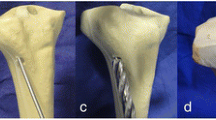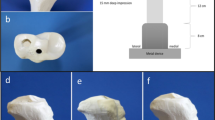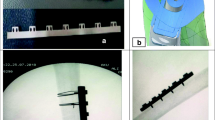Abstract
Background
The aim of this study was to investigate a drillable and injectable bone substitute (calcium phosphate cement) and the operative technique enabled by the drillable option in a new biomechanical fracture model for tibial depression fractures in synthetic bones.
Materials and methods
Lateral depression fractures of the tibial plateau (AO 41-B2, Schatzker III) were created in a biomechanical fracture model in three different synthetic bones (Sawbone 3401, Synbone 1110/1116). Reproducible fractures were generated employing Synbone 1110, which exhibited a comparable strength to human osteoporotic bones and was used for the further experiments. After reduction of the fractures, the stabilization was performed with two different operative techniques. In group 1, first an osteosynthesis with four screws was performed and then the metaphyseal defect was filled up with calcium phosphate cement (Norian drillable). In group 2, initially the filling up with Norian drillable was done enabling a complete filling of the defect, followed by placing of the screws. Displacement under cyclic loading with 250 N for 3,000 cycles, stiffness, and maximum load in load-to-failure tests were determined.
Results
A comparison of the two operative techniques of stabilization showed a distinctly lower displacement and higher stiffness for group 2 when the defect was filled up first. For the maximum load, no significant differences could be demonstrated.
Conclusions
A complete filling of the defect by first applying the calcium phosphate cement significantly reduces the secondary loss of reduction of the depression fracture fragment under cyclic loading with a clinically relevant partial weight bearing. The beneficial effects of drillable calcium phosphate cement may also be transferable to defects other than tibial-head depression fractures.





Similar content being viewed by others
References
Wiss DA. Master techniques in orthopaedic surgery fractures. Philadelphia: Lippincott Williams & Wilkins; 2006.
Kösters C, Schliemann B, Raschke MJ. Tibial head fractures in the elderly. Unfallchirurg. 2011;114(3):251–60. doi:10.1007/s00113-010-1943-0.
Trenholm A, Landry S, McLaughlin K, Deluzio KJ, Leighton J, Trask K, Leighton RK. Comparative fixation of tibial plateau fractures using alpha-BSM, a calcium phosphate cement, versus cancellous bone graft. J Orthop Trauma. 2005;19(10):698–702.
Greenwald AS, Boden SD, Goldberg VM, Khan Y, Laurencin CT, Rosier RN. Bone-graft substitutes: facts, fictions, and applications. J Bone Joint Surg Am. 2001;83(2 suppl 2):S98–103.
Weigel B, Nerlich M. Praxisbuch Unfallchirurgie, vol. 1. Heidelberg: Springer; 2005. p. 656.
Yetkinler DN, McClellan RT, Reindel ES, Carter D, Poser RD. Biomechanical comparison of conventional open reduction and internal fixation versus calcium phosphate cement fixation of a central depressed tibial plateau fracture. J Orthop Trauma. 2001;15(3):197–206.
Welch RD, Zhang H, Bronson DG. Experimental tibial plateau fractures augmented with calcium phosphate cement or autologous bone graft. J Bone Joint Surg Am. 2003;85-A(2):222–3.
McDonald E, Chu T, Tufaga M, Marmor M, Singh R, Yetkinler D, Matityahu A, Buckley JM, McClellan RT. Tibial plateau fracture repairs augmented with calcium phosphate cement have higher in situ fatigue strength than those with autograft. J Orthop Trauma. 2011;25(2):90–5. doi:10.1097/BOT.0b013e3181e3e28f.
Petersen W, Zantop T, Raschke MJ. Tibial head fracture: open reposition and osteosynthesis-arthroscopic reposition and osteosynthesis (ARIF). Unfallchirurg. 2006;109(3):235–44.
Doht S, Lehnert T, Frey S, Fehske K, Jansen H, Blunk T, Meffert RH. Effective combination of bone substitute and screws in the jail technique: a biomechanical study of tibial depression fractures. Int Orthop. 2012;36(10):2121–5. doi:10.1007/s00264-012-1604-8.
Karunakar MA, Egol KA, Peindl R, Harrow ME, Bosse MJ, Kellam JF. Split depression tibial plateau fractures: a biomechanical study. J Orthop Trauma. 2002;16(3):172–7.
Raschke MJ, Stange R. Alterstraumatologie, Prophylaxe, Therapie und Rehabilitation. 1st edn. Urban & Fischer; 2009. pp. 475–487.
Wirth CJ, Mutschler W, Bischoff HP, Pueschmann H, Neu J. Komplikationen in Orthopaedie und Unfallchirurgie. 1st edn. Thieme Verlag; 2010. pp. 275–284.
Zhang W, Luo CF, Putnis S, Sun H, Zeng ZM, Zeng BF. Biomechanical analysis of four different fixations for the posterolateral shearing tibial plateau fracture. Knee. 2012;19(2):94–8. doi:10.1016/j.knee.2011.02.004.
Lindeque B, Baldini T. A biomechanical comparison of three different lateral tibia locking plates. Orthopedics. 2010;33(1):18–21. doi:10.3928/01477447-20091124-25.
Kurien T, Pearson RG, Scammell BE. Bone graft substitutes currently available in orthopaedic practice: the evidence for their use. Bone Joint J. 2013;5:583–97. doi:10.1302/0301-620X.95B5.30286.
Goff T, Kanakaris NK, Giannoudis PV. Use of bone graft substitutes in the management of tibial plateau fractures. Injury. 2013;44(Suppl 1):S86–94. doi:10.1016/S0020-1383(13)70019-6.
Acknowledgments
The first author thanks the IZKF (Interdisciplinary Center for Clinical Research), University Clinics of Wuerzburg, for the financial support of her biomechanical studies. The authors would like to thank Jürgen Schmid from Synthes GmbH for providing supportive information on Norian drillable.
Conflict of interest
The authors declare that they have no conflicts of interest.
Author information
Authors and Affiliations
Corresponding author
About this article
Cite this article
Hoelscher-Doht, S., Jordan, M.C., Bonhoff, C. et al. Bone substitute first or screws first? A biomechanical comparison of two operative techniques for tibial-head depression fractures. J Orthop Sci 19, 978–983 (2014). https://doi.org/10.1007/s00776-014-0613-4
Received:
Accepted:
Published:
Issue Date:
DOI: https://doi.org/10.1007/s00776-014-0613-4




